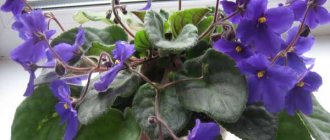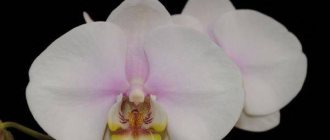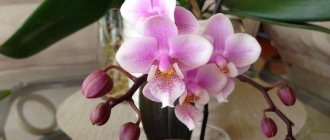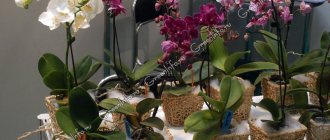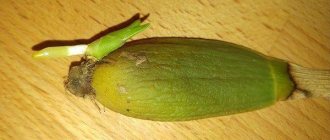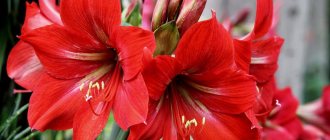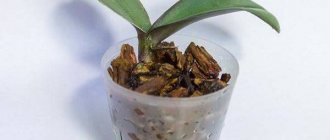The names of the genus of orchids Phalaenopsis come from the Greek Phalaina and Opsis (“night butterfly”, “similarity”) - the shape of the flowers resembles the silhouette of a flying butterfly, the name can be translated as “moth-like”. The genus catalog contains more than 70 species of phalaenopsis, most of which are monopodial epiphytes. K. Blume, a Dutch botanist, first discovered these orchids on an island in the Malay Archipelago. Thanks to selection and hybridization, hundreds of new varieties have emerged based on basic species.
Possible colors
In nature, there are 30 thousand colors of orchids. They come in one-color, two-color, with patterns, all the colors of the rainbow. However, scientists do not stop at this and continue to develop new varieties of phalaenopsis.
In room conditions
At home, all colors of orchids are found. Plants are:
- white;
- light pink;
- purple;
- blue;
- black;
- red;
- radiant;
- pistachio;
- Crayola;
- raspberry;
- burgundy;
- orange.
Hybrids and natural varieties of phalaenopsis take root in indoor conditions.
In the natural environment
Thanks to natural pollination, orchid flowers can be unpredictable in natural conditions. Of course, you won’t be able to find a black or bright blue flower. This is the work of scientists. In nature there are the following shades:
- white;
- pink;
- purple;
- yellow;
- orange;
- light pink;
- peach;
- light purple;
- pistachio
After spontaneous crossing, two-colored petals with a pattern are obtained. Such phalaenopsis are more often found in the wild.
Artificially bred varieties
The variety of orchids is enormous. Below are the most unusual and beautiful hybrid species:
- Wanda Rothschld;
- Cymbidium swordifolium;
- Cattleya Ekland;
- Miltonia flava;
- Phalaenopsis Sander;
- Dendrobium Mix;
- Royal Blue;
- Blue Mystick;
- Cymbidium Black Ruby;
- Phalaenopsis Black Butterfly.
All these varieties have unusual shades that are not found in natural conditions. Blue and black colors do not exist because the plant lacks the pigment to produce such blooms.
Modern scientists have been able to develop such varieties, but after the first flowering the flowers lose their unusual color and become a different color, usually white.
Important! Japanese scientists were able to breed a blue orchid, but it is not yet commercially available.
Orchid leaves and their varieties
Orchid leaves and their varieties are one of the criteria by which a flower is distinguished from others. Since orchids belong to the class of epiphytes (that is, they live on trees and feed through them), their leaves take an active part in the life process. Therefore, it is very important to care not only for the flowers, bulbs and root system, but also for the leaves.
Foliage for orchids plays a very important role, as this class of plants receives moisture and nutrients not only through the roots, but also through the leaves. Leaves also take part in the process of photosynthesis.
A strong and healthy leaf is dense and firmly attached to the stem. The color can be different: from light green to dark tones and variegated colors.
But sometimes the color of the leaves can change, and this is not always good, for example:
- yellow color indicates wilting (most often this is caused by improper watering and humidity);
- purple color is a burn, the flower is damaged by direct sunlight (in this situation it is necessary to move the flower to another place where the light will be diffused);
- the red (brown) color of the leaves indicates that the plant does not receive enough sunlight;
- The black (dark brown) color of the leaves may indicate that the plant is damaged by viral diseases.
To avoid many problems with the flower, it is necessary to properly care for the leaves. A daily inspection will help you notice any changes early.
Advice! Wipe them with a damp cloth. This way you will not only get rid of dust, but also give the flower the opportunity to absorb moisture. Try to use distilled or purified water
Unusual colors
In nature, orchids have different shades and colors. Many plants are painted in 2-3 colors at the same time. This occurs as a result of crossing.
Blue, black and cyan pigmentation in nature
Blue and black pigmentation of petals does not occur naturally. They are bred by scientists in laboratory conditions. Such a plant is able to maintain its color during just 1 flowering, which lasts 8-12 months. New flower stalks will have a different color.
Description
Purple spots, specks, stains on pure white, lilac with a white or pinkish-white background are a very common color of orchid petals, as they are closest to natural . The white and purple orchid occurs in different species.
All features of the appearance of spotted exotics can be grouped as follows:
- Small round spots densely decorate the flower, scattering in rows of beads from its core to the edges of the petals;
- Purple markings are collected along the edges of the white petals and slightly touched the core;
- Purple blots are randomly scattered across the entire surface of the petals. The flower looks like it has been splattered with ink;
- Only the core of the flower is purple;
- The spots are large, but very pale, more like a shadow falling on a white petal.
The color intensity, density and size of the spots may vary .
Orchids that are completely violet or lilac in color are common, but blue is extremely rare; orchids of this color are quite expensive. Supermarkets sell plants that have turned blue using chemicals !
First of all, we need to mention the widespread Phalaenopsis, familiar to every orchid lover. There are several varieties of it, decorated with various purple spots and veins . Dendrobium, Vanda and Cattleya orchids also often present similar colors.
The core, painted in a soft purple color, gives the flower special expressiveness and sophistication. Similar fine examples can be found among Dendrobiums and Phalaenopsis.
The main problem that can disappoint a gardener is the change in color of the petals depending on the conditions of the plant. This happens:
- Increase or decrease in its intensity;
- Violation of the original drawing.
At home
As a rule, phalaenopsis kept at home have flowers in white-pink, red, purple, blue or yellow. In this case, the color depends entirely on the selected plant variety. Most often, the following types of phalaenopsis become decorations for a home flower garden.
Aerides is characterized by a white and pink color palette. Look very decorative.
The inflorescences of this species are usually white-pink or yellow in color.
Ascocentrum
Ascocentrum can have inflorescences of a wide variety of colors. From white to almost all shades of blue and purple.
We recommend watching a video about the features of the Ascocentrum orchid:
The flowers of this species have a characteristic fiery red color.
Neophinetia
Due to the pronounced spur characteristic of this species, neophinetia is called the “Flower of the Samurai”. A very beautiful and unusual flower.
We recommend watching a video about the features of the Neophinetia orchid:
Dendrobium
Dendrobium is one of the popular plants of the orchid family. The most common hybrid is Dendrobium nobile, an orchid with powerful shoots and elliptical leaves. But besides its visual appeal, this plant has one indisputable advantage - even an inexperienced amateur gardener can grow dendrobium.
Phalaenopsis - varieties (key) - C
| Canary flower 8 cm | Cap Gold flower 7 cm |
| Cardinal flower 9 cm | Charleston flower 8 cm |
| Chian Xen 'Angel' | Chian Xen 'Mammon Big Berta' |
| Chian Xen 'Pearl' flower 7 cm | Chian Xen 'Piano' |
| Chian Xen 'Piano 'Anastassia' | Chian Xen 'Red Diamond Ayora' |
| Chian Xen 'Violin' | Chian Xen 'Violin 'Anne' |
| Chian Xen 'Violin 'Sophie' | Chian Xen 'Sweet Valentine' |
| Chiada Stacy 'Chocolate Drop' flower 8 cm | Chili Pepper flower 8 cm |
| Cinders flower 5 cm | Clementine flower 9 cm |
| Cleopatra flower 9 cm | Cool Breeze flower 8 cm |
| Cool Morning flower 6 cm | Cowberry flower 8 cm |
| Cream Bistro flower 9 cm | Cristella flower 6 cm |
| Crown Stripe flower 8 cm | Crystal White flower 5 cm |
| Culiacan flower 6 cm | Cherry Pie flower 7 cm |
| Cali Style | Curacao |
Part 2
Phalaenopsis orchids, varieties starting with the letter
"A" "B" "C" "D" "E" "F" "G" "H" "I" "J" "K" "L" "M" "N" "O" "P" "Q » “R” “S” “T” “U” “V” “W” “X” “Y” “Z”
Related posts:
www.vazonchik.com.ua
List of true blue flowers
If you love this shade in its natural form, then here they are – real blue flowers:
- Blue cornflower (Centaurea Cyanus).
- Morning glory tricolor (Ipomoea tricolor).
- Siberian iris (Iris sibirica).
- Hydrangea (Hydrangea serrata).
- African Lily (Agapanthus).
- Larkspur (Delphinium grandiflorum).
And this is not the whole list.
Features of care
When buying a plant in a store, you need to understand that it was grown in ideal conditions on an industrial farm. The light regime, adjustable humidity and frequency of watering, as well as the methodical application of special fertilizers ensure the full bright color required by the variety standard.
Placed in home rooms and office spaces, exotics experience a deficiency or excess of :
- Sveta;
- Heat;
- Humidity;
- Nutrients.
These orchids need to be cared for in the same way as regular ones.
A change in living conditions cannot but affect the green pet. The greatest influence on the state of coloring is influenced by illumination and the full supply of minerals. But not everything is so critical! Sometimes a new color can even please the owner with more delicate shades . Of course, the standard can almost always be restored with some effort and adjustments in care.
Important! The color of the orchid will constantly change depending on changes in living conditions.
white heron
The white heron is the name given to the orchid Habenaria radiata . Its flowers are unique and resemble a flying bird with pearly white wings. This snow-white orchid is especially popular in Japan precisely because of the unusual shape of the bird-like flowers.
The white egret is very finicky to care for!
Before purchasing a flower, you should familiarize yourself in detail with the features of its cultivation. Lack of lighting or excessive watering can lead to disease and death of the plant.
Phalaenopsis - varieties (key) - B
September 6, 2014 Posted by kamelie | No reviews
| Bee Sting, Breezes, Papagayo, Chiada 'Francis Picotee' flower 8 cm | Barbara Jewel |
| Bedford's Golden Victory | Bistro Leopard flower 8 cm |
| Black Berry flower 7 cm | Bristol flower 9 cm |
| Baby Beauty flower 5 cm | Black Butterfly flower 7 cm |
| Black Velvet | Bijouw Topaz flower 7-8 cm |
| Bingo flower 6 cm | Baldan's Kaleidoscope flower 8 cm |
| Bremen | Bellicose flower 9 cm |
| Bahia Blanca flower 7 cm | Bright Peacock 'Sweet Fragrance' |
| Bro Pico Sweet flower 4 cm | Bro Red King flower 8 cm |
| Bro Sara Gold flower 9 cm | Brown Sugar flower 5 cm |
| Burgundy Champagne | Burgundy Red |
| Be Tris | Big Smile |
| Black Peacock | Black Swan |
| Bananarama flower 7 cm | Bubble Gum 'Schwartz' |
| Brother Oconee 'Red Dream' | Brother Oconee 'Bedford' |
| Bajazzo | Banu |
| Bayamo flower 9 cm | Beyonce flower 3 - 5 cm |
Part 2
Phalaenopsis orchids, varieties starting with the letter
"A" "B" "C" "D" "E" "F" "G" "H" "I" "J" "K" "L" "M" "N" "O" "P" "Q » "R" "S" "T" "U" "V" "W"
"X" "Y" "Z"
Related posts:
Category: Orchids | Tags: varieties, phalaenopsis | Permanent link
www.vazonchik.com.ua
Reproduction methods
Orchids are propagated using:
- dividing the bush, which is rarely done due to the danger of the procedure for the plant;
- children separated after flowering from the leaf axils or from the peduncles of a two-year-old or older plant;
- cuttings - cut pieces of a peduncle with a “sleeping” bud, which are laid out on a moist substrate. At constant temperature and humid air, the roots and leaves of the plant will appear.
Method of dividing a bush.
Recommendations from flower growers:
- preparation for reproduction requires disinfection of tools and their sharpening, washing hands with soap;
- the inflicted “wounds” are treated with crushed chalk, colloidal sulfur, activated carbon and wood ash. You cannot use iodine and brilliant green.
History of breeding
The history of the white orchid went in several directions: the plant was needed for cut flowers and for growing in a pot. The homeland of the orchid is considered to be South and East Asia . It was from there that the orchid was brought and selected for other climatic conditions.
The white-flowered orchid was most popular between 1930 and 1950. The main reason for this popularity was the improvement of this type. It had large snow-white flowers, and the plant boasted a long arrow with a huge number of peduncles.
Modern botanical classification
According to the growing environment and the method of attachment to nutrient media, they are distinguished:
- Epiphytes. A variety of flowers that grow on other plants, but are parasitic on them. The root system plays an extremely important role for this species, since it stabilizes the flower and its nutrition. Examples of epiphytes: Variety Dendrobium.
- Lithophytes. They are attached to rocks and rocky surfaces. They have a very developed root system and obtain nutrients using pseudobulbs. Example: Cattleya.
- Ground. Flowers that grow mostly in soil. Bush orchid family. Example: Cymbidium.
By belonging to subfamilies:
- Apostasioideae/Apostasiaceae. This family of orchids is native to eastern Asia. It consists of 2 genera. Neuwiedia and Apostasia, in the amount of 16 species.
- Cypripodioideae/Cypripediaceae. Combines all 3 species - epiphytes, lithophytes, terrestrial orchids. It consists of 5 genera, in which there are 130 species. One of the most famous representatives is Venus's Shoe.
- Vanilloideae/Vanilla. Unites 15 genera, numbering 180 species. Lianas and herbs - these plants are characterized by a large number of flowers. Representatives of the Vanilla genus contain vanilla, which is used in food, medicine, and perfumery.
- Epidendroideae/Epidendraceae. The most numerous subfamily, which includes 500 genera, which contains 20 thousand species. Among them there are epiphytes, terrestrial ones, and lianas.
The most popular is the Cattleya species, which is distinguished by its voluminous, numerous inflorescences and wonderful aroma.
Wanda
This exotic beauty has a caramel aroma and a long flowering period. Peduncles form in the axils of long narrow leaves. With sufficient lighting and timely watering, the plant produces up to 4 flower stalks with 15 flowers on each. Wanda is quite capricious and demanding of lighting and air humidity.
Landing
The technology for planting white orchids is practically no different from planting other representatives of this family.
Priming
The substrate differs in many ways from the soil for other indoor plants and must have the following characteristics :
- Have good air permeability;
- Moderate moisture capacity;
- Slightly acidic soil reaction.
The soil for orchids should be well breathable and absorb water.
The main components of soil mixtures for orchids:
- Pieces of pine bark;
- Whole or cut sphagnum moss;
- Expanded clay, ceramic shards, pieces of foam plastic;
- Pieces of charcoal.
Flower soil is not used to prepare the substrate
Optimal capacity
The flowerpot must meet the following requirements :
- Have drainage holes;
- Its volume must correspond to the volume of the root system;
- Through the transparent walls you can observe the condition of the roots.
A plastic pot with transparent walls is most convenient for growing orchids.
Technology
A few days before transplanting, it is not recommended to water , after which:
- The plastic pot is cut;
- The plant along with the substrate is placed in a container of water to soften the soil;
- The substrate remaining on the roots is washed off;
- Damaged roots are cut off, the sections are covered with crushed charcoal, and dried.
After this, the orchid is ready for planting .
When planting, plants adhere to several mandatory rules :
- At the bottom of the flowerpot, create a 5 cm drainage layer of expanded clay and perlite, which can be replaced with polystyrene foam balls;
- A substrate 5-6 cm high is laid on top of the drainage, on which the orchid is placed;
- The roots are covered with soil mixture and the plant is briefly lowered into a container of water.
If necessary, top up the soil .
Deadlines
The white orchid can be replanted only after flowering has finished . It is best to do this in the spring, during the period of active vegetative growth of the plant.
During flowering
Replanting a flowering plant is very stressful , as a result it can lose its flower and even die.

